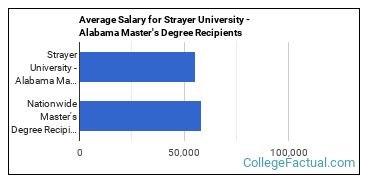 by our College Data Analytics Team
by our College Data Analytics TeamWomen make up 80.4% of the total graduate student body at Strayer University - Alabama while men make you 19.6%. These percentages may be different for specific degree programs.

Racial-ethnic minorities* make up 88.7% of the graduate student population at Strayer University - Alabama. For more details on graduate school diversity at the school, check out the chart below. If you click on it, you'll be taken to a page with more details.

The average tuition and fees for graduate students is shown below.
| In-State | Out-of-State | |
|---|---|---|
| Tuition | $14,940 | $14,940 |
| Fees | $195 | $195 |
Graduate students earning a master's degree from Strayer University - Alabama enter careers with an average starting salary of $55,502. Unfortunately for those graduates, that figure is about 5% lower than the national average of $58,425.

Get more details about the location of Strayer University - Alabama.

Contact details for Strayer University - Alabama are given below.
| Contact Details | |
|---|---|
| Address: | 2 20Th Street North, #150, Birmingham, AL 35203 |
| Phone: | 877-455-7180 |
| Website: | www.strayer.edu/campus-locations/alabama/birmingham |
| Facebook: | https://www.facebook.com/StrayerUniversity |
| Twitter: | http://www.twitter.com/strayeru |
During the 2020-2021 academic year, 100.0% of the graduate students at Strayer University - Alabama took all of their courses online.

The only degree programs listed here are those in which master’s degrees were awarded in 2020-2021.
Footnotes
*The racial-ethnic minorities count is calculated by taking the total number of students and subtracting white students, international students, and students whose race/ethnicity was unknown. This number is then divided by the total number of students at the school to obtain the racial-ethnic minorities percentage.
References
More about our data sources and methodologies.